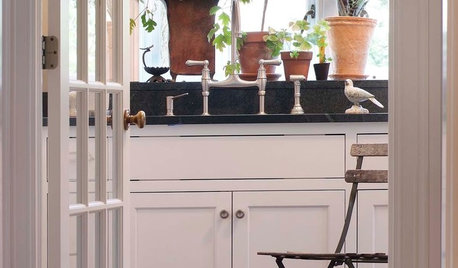No house wrap? HELP
So, now that the framing is done and our windows are in, its time for siding. Well, we didnt realize our builder doesnt use house wrap. He says he puts a moisture barrier behind the drywall and doesnt like house wrap because the house cant "breathe". We talked to another builder when we were interviewing who had the same feelings and didnt use house wrap. So, my DH is installing the siding and he is tempted to go buy house wrap and put it up there. Normally I guess the house wrap should go on BEFORE windows. So, our question is.... Do we need house wrap and if so can we still put it up without causing problems? We live in NE Ohio if that makes a difference.
Thank You! We have been really struggling with what to do here.
Comments (32)
stinkytiger
15 years agoHi,
Rule number 1: *Don't Panic*, (Hitchikers Guide to the Galaxy.)
You need some reassurance from a neutral person. Why don't you give a call to your local building inspector in your town. He will have to sign off on your house before you get C-of-O anyways. He will also know what works best for residential construction in your area.
OK vapor barriers and condensation and mold. First off we need to understand a little bit about how condensation occurs. When warm air holding moisture is cooled sufficiently, water droplets drop out to form condensation. The exterior walls of your house have a temperature gradient across them. Inside is maybe 70 and outside may be 20 degrees F in the winter. If wet warm air traverses this temperature gradient, you will get condensation.
Vapor barriers are usually found stuck to fiberglass bats. The vapor barrier goes on the warmside of wall, next to the the drywall, inside the house. This helps stop warm most year getting into the insulation. The barrier is however behind the drywall. Usually there is some small air gap and hence air circulation behing the drywall but not that much. Note that this area behind your dry wall is warm. No temperature gradient. The temperature gradient occurs across your insulation. But your insulation is shielded from the warm moist air by the vapor barrier. Hence where the temperature gradient would cause condensation, the air is relatively dry.
House wrap, e.g. DuPont Tyvek, goes on the wood sheets, and is covered up by a waterproof siding / shingles. Tyvek is like GoreTex a-la Mountain jackets but for houses. It is waterproof but allows smaller water vapor droplets through. If Tyvek is a good idea or not depends on where you are. If you are in say New York, where the air is usually quite dry, then moisture will go from inside your wall to the outside. BUT if you are in a very humid climate, then the water moisture will go the other way. All these North Face jackets work great in cold climates and on mountains where the air is dry. Wear the same North Face jacked in the jungles of Asia Pacific and you will be really sweaty fast. Moisture goes in because it is so humid outside the jacket.
Most wall systems also have some sort of limitied air circulation so that if some moist air gets in, it can still circulate out.
I am not a builder so I hope I am give O.K. advice. My brother who is an Architect explained this all to me once. I hope I have remembered it correctly.
Warmest regards, Mike.
P.S. Here is my Brother's Hotel in Italy, a bit of a blatent plug....
Here is a link that might be useful: Hotel of Architect Brother
Related Professionals
Doctor Phillips Architects & Building Designers · Middle River Architects & Building Designers · Oak Hill Architects & Building Designers · Beavercreek Home Builders · Duarte Home Builders · Miami Home Builders · New Bern General Contractors · Dover General Contractors · Hillsborough General Contractors · La Grange Park General Contractors · Leon Valley General Contractors · Mount Vernon General Contractors · New Braunfels General Contractors · Pinewood General Contractors · Saginaw General Contractorsworthy
15 years agoLOL. Arthur Dent is my avatar on another site!
I was a licenced builder across the Lake in Ontario for 20 years, off for a year, and am constantly trying to learn the best methods as taught by Building Science Corp., for instance.
I would take a different approach were I building your home. But your builder is not doing anything "wrong."
The interior vapour barrier is Code required, the housewrap is not. So your builder is not offbase on that.
Adding housewrap at this point, when the windows and doors are in, may cause water problems around them. As well, since the wrap isn't tucked into and over the sills, it's not much use as an air barrier. There are spray applied wraps that can be used at this point to help in shedding liquid water---which is the real reason housewraps are a good idea, says Building Science's Dr. Lstiburek.
You haven't mentioned what your house is to be clad with--brick, wood siding, Hardie etc. I only build with brick and stone (some EIFS stucco). As long as the proper method of creating a drainage plane is used there, I wouldn't be concerned.
BTW, I wouldn't call 32-64 inches of annual rainfall "dry".
"Don't Panic."
worthy
15 years agoOK, I missed it's siding. Whatever siding it is, follow the manufacturer's directions or the relevant Codes or industry association guidelines for installation.
twogirlsbigtrouble
Original Author15 years agoThe siding would be vinyl with some stone we are not doing the stone. I would use the house tape around the windows or even some Ice And water shield. If it came to it i would take out the windows on the weather sides of the house. It is an all gable ranch so the wrap would run above the walls inside. Hope this helps. Help! I just dont want to regret Either thing we do.
SuzieSnowflake
15 years agoGood grief. I try to stay away from this forum so I can close those chapters of my life but it keeps drawing me back from time to time. I lived a homebuilding nightmare, lawsuits, mold, rot, etc. that consumed my life for years.
Tell your builder to pull the windows and do the job right. A bunch of half baked solutions is not going to lead to a well built house. It rains in Ohio. You NEED a well done drainage plane - housewrap (or #30 felt) integrated with flashing at ALL exterior penetrations (windows, doors, hose bibs, electrical outlets, light fixtures, dryer vents, etc.)
Here is some information to get you started:
Fine Homebuilding - Rain Screen Wall Article - http://www.taunton.com/finehomebuilding/how-to/articles/siding-with-rain-screen-walls.aspx?ac=ts&ra=fp
ASTM Standard for Door, Window and Skylight installation - http://www.astm.org/Standards/E2112.htm
Grace website (flashing manufacturer with good information) - http://www.graceathome.com/
Homeowners Against Deficient Dwellings (what happens to innocent home buyers when builders don't know how to build a house) - http://www.hadd.com/
Read all of this stuff and decide for yourself if you want your builder to just slap up the siding without housewrap (and without flashing I assume).
I knew this economy would hurt builders but I was hopeful that only the good would survive. Seems the sleaziest are finding a way to thrive too.
Here is a link to one of the best resources out there (thank you SO much Rollie).
Here is a link that might be useful: Rollie's website about Delores' House
worthy
15 years agoIf this late in the day you're suddenly asking the builder to utilize every last state-of-the-art waterproofing idea you can Google up, be prepared to pay for it. And I suggest you get a building professional to direct the builder.
Homes were built for years without housewraps with no particular water problems. And the way housewraps and flashings are many times applied now they can cause more water problems than they cure.
For anybody still in the planning stages, the best way to incorporate these details is in writing and pictures in the building plans.
Here is a link that might be useful: See Water Management Details
SuzieSnowflake
15 years agoThank you for a great link Worthy. However, I disagree with your implication that the OP is wrong to expect his/her builder to build a house that will keep the water OUTSIDE. Rain water should be dealt with. Period.
Yes, it's true that houses used to survive water intrusion. However, that was when houses were built with real wood and not wood fibers compressed with glue (which, as you surely know is ideal mold food).
After only one year I saw first hand, with my own eyes, the damage water can cause a house without a good drainage plane system. I firmly believe that the only reason others aren't aware of the damage to their homes built with crappy or non-existent drainage planes is because they haven't pulled the siding off like we did.
OP - I believe you are well within your rights to expect your builder to build a house that is going to be safe for human habitation (if mold and rot take over, it will not be safe to live in). The information I provided for you is not just random stuff I googled up - it is tried and true and based upon recommendations from our structural engineers provided to us when we had to tear apart and rebuild the crap my builder built.
Yes, ideally this information should be included in your contract. However, it is not a perfect world. If we had to include every possible thing in a contract, the contract would be so big it would take a truck to move it (and no builder would ever read it).
Some things are just basic, for example, does your contract state that you want water to come out of the faucet? That you want electricity to turn on the lights? That you want doors to open and close? Some things are just too basic. Just like keeping the elements, such as rain OUTSIDE. That's the whole purpose of building shelter.
Worthy is correct, however, that anyone in the planning stages should do everything possible to include every possible thing in the contract, right down to what nails to use, how many and where to nail them because when push comes to shove in a courtroom, you need something on your side when your builder is a moron.
Worthy is also correct that incorrectly applied housewrap and flashing can cause water problems. Make sure your builder does the job right. If you personally don't know the the correct applications, hire someone who does - like a structural engineer. Do NOT pay your builder until the job is done right. Do NOT count on your city building inspectors (I have first hand knowledge that they sometimes don't even bother showing up to the building site to approve the work).
Get your builder to do the job right. A little hassle with him now is much better than spending years battling in court while trying to repair what he screwed up.
sierraeast
15 years agoBack in the mid eighties on cape cod, standard application of white cedar shingles on the walls and red cedar shingles on the roof was done with no underlayments, nailed directly to the plywood sheathings. Strips of felt were placed on corner trims, around window and door openings. I always thought this was weird until we replaced shingles on some late 1700- 1800 period homes and inns that the shingles had been replaced a time or two before we worked on them. Pulling off the old shingles revealed little or no rot with no evidence of there ever being underlayments, which simply weren't used on projects that old. Very surprising. If the vinyl product you are using has the foam backing on it, there's basically your wrap. If not, typically a foam underlayment is placed before the vinyl. You are definetely going to need a drainage plane in the areas of the stone similar to brick veneer and stucco applications. Underlayment will be needed in those areas. Good old reliable 30# saturated felt has always been a friend, (correctly installed along with all correctly installed flashings), to wall systems.
sierraeast
15 years agoWhatever underlayment is applied, with most, it's best to install the windows in conjunction with the underlayment along with properly flashing the perimeters. Pull all the windows for proper install, not just the weather side windows. Pulling the windows isn't that big a deal in the overall spectrum of getting your house weather tight. It's not the physical rain water that is the concern, but moisture that collects behind claddings such as stone and your vinyl. You will need a proper drainage plane along with proper flashings as well as an avenue of escape at the base to rid this moisture. Do your homework and research how to properly do this despite your builders claims.
manhattan42
15 years agoSection R318 of the 2007 Ohio Residential Construction Code requires a vapor barrier on the warm-in-winter side of framed walls, ceiling and floors that make up the building's thermal envelope:
http://publicecodes.citation.com/st/oh/st/b4v06/st_oh_st_b4v06_3_section.htm?bu=OH-P-2005-000004
Section R703.2 and R703.4 of the same Code requires a weather resistant barrier over the structural sheathing under vinyl siding:
Bottom line:
You are REQUIRED BY LAW to use both a vapor barrier and a weather barrier in framed wall assemblies.
Case closed.
manhattan42
15 years agoTable R 703.2 DOES NOT REQUIRE a weather proof barrier over sheathing and under vinyl siding in Ohio.
This is unique to Ohio. The 2006 versions of the International Residential Code upon which the Ohio Code is based DOES require a weather proof barrier under nearly all sidings.
Do yourself a favor and install it anyway.
It is not necessary to remove windows in order to properly install the weather barrier.
worthy
15 years agoGood old reliable 30# saturated felt has always been a friend, (correctly installed along with all correctly installed flashings), to wall systems.
That's what I used for years before under brick and stone. Even after housewraps started being used here in the '90s (they originated in the '80s) bricklayers still insisted on adding the felt.
Window and door flashings and pans are rare and not Code required here.

Belt and Suspenders: Sceptical bricklayers insist on using housewrap and #30 felt (Heather Joy Investments Ltd.)And even when they're used, the applications can be eccentric.

Resisto flashing on one of 25 windows on a luxury home under construction. The flashing is applied contrary to the
manufacturer's instructions and is counterproductive.Unless you mutually agreed to something else in writing, your builder is only obligated to meet Code, not "best practices."
worthy
15 years agoIt is not necessary to remove windows in order to proper install the weather barrier.
But best to, especially as I take it there is no flashing maybe not even poly used at all.
sierraeast
15 years agoYou've got excellent references/links from Worthy and Suzie, so study up and find the best application for your project. Best of luck! Let us know how it's going and the direction you are taking. Referencing code minimums from the area's requirements isn't always a route to consider. You sometimes need to take measures to exceed those codes as long as they stay on track with them.
manhattan42
15 years ago" 'It is not necessary to remove windows in order to proper install the weather barrier.'
But best to, especially as I take it there is no flashing maybe not even poly used at all."
No. Not "best"....Just one of many ways to skin the flashing and weatherbarrier cat.
Proper installation of the weather barrier can be done with the windows already set in place, provided it is installed over the top and side nailing fins of the windows, placed under the bottom fin, and then properly flashed.
mightyanvil
15 years agoMany building envelope experts believe a weather/air barrier should be installed after the windows are installed and DuPont (Tyvek) publishes instructions for that method, WR Grace (Vycor) recommends it, many window manufacturers recommend it (Jeld-Wen, etc.), and it is described in detail as one of the accepted methods in ASTM E2112-07.
If you are having trouble sorting out confusing and contradicting information you should consult with a design professional. I can't advise you without knowing all existing conditions.
mightyanvil
15 years agoStay away from all housewraps that are woven or perforated. It is best to stick with Tyvek, Typar, and WeatherSmart or asphalt saturated felt.
Some day I would like to hear an explanation of what it means for a house to "breathe". It seems like an intentional conversation stopper from people who aren't able to discuss moisture movement in buildings.
worthy
15 years agoI should (almost) always avoid absolutes. However, where the housewrap is used as part of the exterior air barrier, it should extend as continuously as possible over sills, flashings and windows. See Building Science onAir Barriers.
Here's a Bob Vila video of this method. Tyvek also shows the same method in its Installation Guide: http://www2.dupont.com/Tyvek_Construction/en_US/assets/downloads/InstallGuideWRB_K16282.pdf.
We're getting into the nitty gritty here of which it seems lots of so-called builders haven't a clue. It's a nice cold day here. So I think I'll take a stroll and shoot some more pics illustrating that thesis.jasonmi7
15 years agoThe thesis of it being a cold day?
MA, yes, I always wondered about that 'house has to breathe' term as well, but it usually is either preceded or followed by "they" not building them like they used to, to which my reply was always "Thank God." :-)
mightyanvil
15 years agoI agree that an air barrier is not very effective unless it is not carefully installed at the sill and the eave as well as taped at all joints and nailed with cap nails. I'd show you some photos but I've never actually seen it done except in magazine articles.
brickeyee
15 years agoI think the 'breath' term gets bandied about by folks who do not really have much knowledge of moisture movement in houses.
Despite all the nice siding, it is not only waterproof in the sense it is not damaged by water.
Water will penetrate past siding and another barrier needs to be present under the siding to establish a drainage plane to prevent further intrusion into the structure.
This layer needs to prevent liquid water from moving past but NOT water vapor.
Vapor still needs a path out of the wall.twogirlsbigtrouble
Original Author15 years agoThank you to all who have replied!
After much research and discussion we have decided to just buy the housewrap and put it up ourselves. We talked to the builder about it and he said that was fine, its our house. Of course we are paying for it and installing it, but it will give us alot of peace of mind. Its not code here and it wasnt listed in the contract (something we overlooked) so we cant really expect him to foot the bill unfortunately. In the end though, we'll feel better and we'll only be out a few hundred bucks. Isnt building fun? :)
dennis_aspo
8 years agoI've never seen house wrap used. I think it's a north american thing because your construction techniques often require it, like your non-universal adaption of rainscreen instead using single layer paneling.
We just built a house and here (Finland. Sweden, etc) and we put the moisture barrier (special type of plastic and special type of tape) on the inside. This ofcourse requires a good mechanical ventilation in a modern house.
The biggest reason for the air barrier is that fiberglass/rockwool's hydroscopic, in older houses they use organic insulation like sawdust that can withstand moisture better and since there is no barrier, the moisture continually moves freely frominside out and it can dry out. This isn't possible using fiberglass or rockwool style insulation.
Rain screen is probably the major reason you don't need house wrap. Commonly here the exterior is first paneling, which is wood, vinyl hasn't caught on here and hopefully won't. Then comes an air space to protect the exterior grade drywall (OSB and such hasn't caught on either).
Then insulation which is usually plain rockwool or fiberglass wool, 250mm I think was used in our house, then the moisture barrier comes, then another air barrier of 45mm (can also be filled with rockwool, a little insulation inside the vapor barrier is OK, but no more than that), then interior drywall. The main purpose of this is to prevent the barrier from getting holes in it when putting up paintings and such.
So anyway my point is housewrap isn't anything that is super neccessary, we don't ever use it here, but we also only build using rain screen which makes house wraps unneccesary. IMO rainscreen is a simpler and superior way to build.I must say in our arctic climate I don't see how an exterior grade wrap with all the insulation on the inside wouldn't lead to severe mold issues in a very short time span, perhaps it works where it's warmer but here it looks like a disaster waiting to happen.
millworkman
8 years agoAlso dennis, the post you dug up is SIX years old so I am not sure what your purpose is other than to bring up something which is part of the building codes and not really even able to be debated with the building departments.
Sanford W.
8 years agoAlso, the house wrap used here is highly vapor impermeable so none of the moisture issues raised by dennis apply. The interior air barrier concept was tried here and abandoned many years ago.
John Crittenden
8 years agoExterior moisture barriers are vapor permeable but not water permeable. They do not breath water in, nor do they retain humid air. This is the dual function. basically keeping water out while "breathing" out the humid air. Water can easily penetrate siding at outside corners, around windows, at inside corners. I recently inspected a sixplex that had used alphaultic building paper on the outside, but the installer just used flat sheets cut at the corners. Corners are the most vulnerable point for moisture penetration. the studs and sheathing were rotting ont he windward side.
A vapor retarder like polyethylene on the inside is just that, a sheet that retards the migration of warm moist air into the cavity. It is not perfect, and neither are the installers, so moist air seeks its way from the warm humidity pressurized interior to the cold, dry exterior on cold days. That is just the way the physics work. You cut down the humidy penetration as much as possible, then release it out the other side in its vapor form.
Modern sheeting materials are much less vapor permeable than polyethylene. LIkewise, exterior moisture barriers can be used to float a boat while still allowing the humid air to escape.
I agree about the vulnerability of a lot of modern siding materials, not like they used to be. Also, older houses were well ventilated and did not have the same problems we have with our modern energy efficient, tight houses.
The best way to reduce or eliminate the drive of humid moisture into a cavity is to use some kind of passive or mechanical air to air heat exchanger.
John
John Crittenden
8 years agodennis-aspo, do I understand that you make a rainscreen house without a moisture barrier. Rainscreen construction allows water to penetrate through the siding, then in the baffled quiet interior cavity, the water falls easily down and dries up due to the ventilated cavity. It still needs to be directed away from the wood and insulation. No breathable membrane?? I will have to investigate this phenomenon. John


















twogirlsbigtroubleOriginal Author